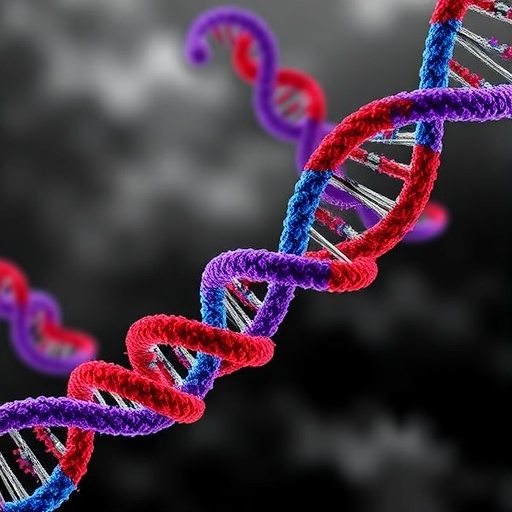CRISPR-Cas systems represent a groundbreaking advancement in the field of genetic engineering, allowing for targeted modifications of genomes across various organisms. These adaptive immune systems, initially discovered in prokaryotes, defend against viral infections by employing RNA-guided endonucleases for the precise cleavage of invasive nucleic acids. Among these systems, Type V CRISPR-Cas systems, particularly the Cas12 variant, have emerged as powerful tools in the realms of medicine, agriculture, and biological research. The recent findings elucidated by a collaborative team led by Professor GAO Caixia from the Institute of Genetics and Developmental Biology (IGDB) and including researchers from Tsinghua University and the Institute of Zoology of the Chinese Academy of Sciences (CAS) provide valuable insights into the evolutionary origins of these remarkable molecular mechanisms.
Their extensive research has revealed that the functional diversification of RNAs, derived from transposons, played a crucial role in the evolutionary advent of Type V CRISPR-Cas systems. The findings were published in the prestigious journal Cell, marking a significant advancement in our understanding of the intricate molecular innovations that facilitated the transition from transposon activity to CRISPR immunity. Understanding these transitions is vital, as it not only elucidates the evolutionary history of CRISPR systems but also paves the way for innovative applications in genome editing technologies.
The researchers utilized a systematic approach that combined the analysis of catalytic motifs, structural domains, and sequence similarities to trace the evolutionary lineage of Type V CRISPR-Cas systems. This method allowed the team to identify and characterize 146 CRISPR-associated proteins that are homologous to TnpB nucleases, previously recognized as the ancestral proteins of Cas12. The identification of these proteins was facilitated by exhaustive searches in prokaryotic genomes and metagenomic databases, providing a comprehensive understanding of the genetic and structural transitions that have occurred throughout evolutionary history.
Through phylogenetic analyses and advanced predictive modeling using AlphaFold, the researchers delineated six distinct clades, collectively termed TranCs. These clades represent critical evolutionary intermediates, highlighting the relationship between TnpB nucleases and Cas12 systems. This discovery underscores the evolutionary significance of these molecular adaptations, which were previously obscured by a lack of concrete understanding of the transitional forms that bridge the gap between transposon systems and CRISPR immunity.
The study found that specific TranC systems exhibit a unique dual-guide RNA mechanism, which is unprecedented in CRISPR-Cas biology. Five TranC systems were shown to employ both intrinsic CRISPR RNAs and transposon-derived regulatory RNAs, facilitating effective DNA targeting through a versatile and adaptive mechanism. This novel dual-guidance capability signifies the evolutionary potential and flexibility of TranCs, providing a functional signature that indicates their role as crucial intermediates in the lineage leading to Type V CRISPR-Cas systems.
Cryo-electron microscopy (Cryo-EM) analyses of the LaTranC-sgRNA-DNA complex revealed remarkable structural parallels to the TnpB-reRNA-DNA assemblies. The researchers found that the ancestral reRNA had been functionally resolved into two distinct components, namely tracrRNA and crRNA. This transformation reflects an essential evolutionary step in the development of CRISPR systems, emphasizing the importance of RNA-level innovations as primary drivers of molecular evolution, rather than extensive protein structural changes.
The implications of this study extend beyond evolutionary theory; the engineering experiments conducted further illustrate the capacity of RNA-level innovations to convert TnpB into a CRISPR-like system capable of utilizing CRISPR arrays for guide RNA production. Such findings suggest a framework for developing novel CRISPR technologies that are not only smaller but also more versatile and controllable—qualities that are indispensable in the advancement of biomedical applications and genetic research.
As CRISPR technology continues to evolve, understanding its molecular origins becomes increasingly critical. The elucidation of RNA splitting mechanisms and their role in the emergence of Cas12 from transposons represents a significant leap forward in our comprehension of genetic engineering tools. These advancements hold profound potential for improving genome editing techniques, making them more efficient and accessible for diverse applications across medicine and agriculture.
The work of the research team enriches the existing body of knowledge surrounding CRISPR systems, highlighting how evolutionary dynamics can influence the development of complex molecular systems. This research not only uncovers the intricate evolutionary pathways leading to the Type V CRISPR-Cas systems but also signifies a profound shift in the way scientists approach genetic design, opening new avenues for exploration in the genetic realm.
In conclusion, as we delve deeper into the mechanisms that underlie one of the most powerful tools in genetic engineering, the emerging picture reveals an elegant interplay of nucleic acid evolution and molecular innovation. This ongoing research emphasizes the need for continued exploration of the evolutionary connections between transposable elements and CRISPR technology, as understanding these relationships is paramount for future applications in genetic medicine and biotechnology.
Subject of Research:
Article Title:
News Publication Date:
Web References:
References:
Image Credits:
Keywords
Tags: Cas12 variant applicationsCRISPR-Cas systemsevolutionary origins of CRISPRfunctional diversification of RNAsgenetic engineering advancementsimplications for medicine and agricultureinsights from collaborative researchmolecular innovations in geneticsRNA-guided endonucleasestransposons in CRISPR evolutionType V CRISPR-Cas systemsviral infection defense mechanisms





